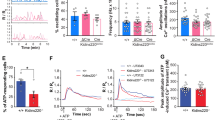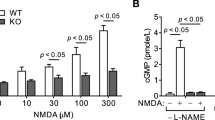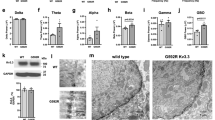Abstract
Channels formed by the transient receptor potential (TRP) family of proteins have a variety of physiological functions. Here we report that two members of the TRP cation channel (TRPC) subfamily, TRPC3 and 6, protected cerebellar granule neurons (CGNs) against serum deprivation–induced cell death in cultures and promoted CGN survival in rat brain. In CGN cultures, blocking TRPC channels or downregulating TRPC3 or 6 suppressed brain-derived neurotrophic factor (BDNF)–mediated protection, BDNF-triggered intracellular Ca2+ elevation and BDNF-induced CREB activation. By contrast, overexpressing TRPC3 or 6 increased CREB-dependent reporter gene transcription and prevented apoptosis in the neurons deprived of serum, and this protection was blocked by the dominant negative form of CREB. Furthermore, downregulating TRPC3 or 6 induced CGN apoptosis in neonatal rat cerebellum, and this effect was rescued by overexpressing either TRPC3 or 6. Thus, our findings provide in vitro and in vivo evidence that TRPC channels are important in promoting neuronal survival.
This is a preview of subscription content, access via your institution
Access options
Subscribe to this journal
Receive 12 print issues and online access
$209.00 per year
only $17.42 per issue
Buy this article
- Purchase on Springer Link
- Instant access to full article PDF
Prices may be subject to local taxes which are calculated during checkout







Similar content being viewed by others
References
Minke, B. Drosophila mutant with a transducer defect. Biophys. Struct. Mech. 3, 59–64 (1977).
Montell, C., Jones, K., Hafen, E. & Rubin, G. Rescue of the Drosophila phototransduction mutation trp by germline transformation. Science 230, 1040–1043 (1985).
Clapham, D.E., Runnels, L.W. & Strubing, C. The TRP ion channel family. Nat. Rev. Neurosci. 2, 387–396 (2001).
Clapham, D.E. TRP channels as cellular sensors. Nature 426, 517–524 (2003).
Montell, C., Birnbaumer, L. & Flockerzi, V. The TRP channels, a remarkably functional family. Cell 108, 595–598 (2002).
Montell, C. The TRP superfamily of cation channels. Sci. STKE 2005, re3 (2005).
Montell, C. et al. A unified nomenclature for the superfamily of TRP cation channels. Mol. Cell 9, 229–231 (2002).
Aarts, M. et al. A key role for TRPM7 channels in anoxic neuronal death. Cell 115, 863–877 (2003).
Segal, R.A. & Greenberg, M.E. Intracellular signaling pathways activated by neurotrophic factors. Annu. Rev. Neurosci. 19, 463–489 (1996).
Bibel, M. & Barde, Y.A. Neurotrophins: key regulators of cell fate and cell shape in the vertebrate nervous system. Genes Dev. 14, 2919–2937 (2000).
Huang, E.J. & Reichardt, L.F. Trk receptors: roles in neuronal signal transduction. Annu. Rev. Biochem. 72, 609–642 (2003).
Pettmann, B. & Henderson, C.E. Neuronal cell death. Neuron 20, 633–647 (1998).
Minichiello, L. & Klein, R. TrkB and TrkC neurotrophin receptors cooperate in promoting survival of hippocampal and cerebellar granule neurons. Genes Dev. 10, 2849–2858 (1996).
Schwartz, P.M., Borghesani, P.R., Levy, R.L., Pomeroy, S.L. & Segal, R.A. Abnormal cerebellar development and foliation in BDNF−/− mice reveals a role for neurotrophins in CNS patterning. Neuron 19, 269–281 (1997).
Bonni, A. et al. Cell survival promoted by the Ras-MAPK signaling pathway by transcription-dependent and -independent mechanisms. Science 286, 1358–1362 (1999).
Brunet, A., Datta, S.R. & Greenberg, M.E. Transcription-dependent and transcription-independent control of neuronal survival by the PI3K-Akt signaling pathway. Curr. Opin. Neurobiol. 11, 297–305 (2001).
Li, H.S., Xu, X.Z. & Montell, C. Activation of a TRPC3-dependent cation current through the neurotrophin BDNF. Neuron 24, 261–273 (1999).
Shim, S. et al. XTRPC1-dependent chemotropic guidance of neuronal growth cones. Nat. Neurosci. 8, 730–735 (2005).
Li, Y. et al. Essential role of TRPC channels in the guidance of nerve growth cones by brain-derived neurotrophic factor. Nature 434, 894–898 (2005).
Wang, G.X. & Poo, M.M. Requirement of TRPC channels in netrin-1–induced chemotropic turning of nerve growth cones. Nature 434, 898–904 (2005).
Shaywitz, A.J. & Greenberg, M.E. CREB: a stimulus-induced transcription factor activated by a diverse array of extracellular signals. Annu. Rev. Biochem. 68, 821–861 (1999).
Riccio, A., Ahn, S., Davenport, C.M., Blendy, J.A. & Ginty, D.D. Mediation by a CREB family transcription factor of NGF-dependent survival of sympathetic neurons. Science 286, 2358–2361 (1999).
Hardingham, G.E., Fukunaga, Y. & Bading, H. Extrasynaptic NMDARs oppose synaptic NMDARs by triggering CREB shut-off and cell death pathways. Nat. Neurosci. 5, 405–414 (2002).
Rosen, L.B., Ginty, D.D., Weber, M.J. & Greenberg, M.E. Membrane depolarization and calcium influx stimulate MEK and MAP kinase via activation of Ras. Neuron 12, 1207–1221 (1994).
Dolmetsch, R.E., Pajvani, U., Fife, K., Spotts, J.M. & Greenberg, M.E. Signaling to the nucleus by an L-type calcium channel–calmodulin complex through the MAP kinase pathway. Science 294, 333–339 (2001).
Wu, G.Y., Deisseroth, K. & Tsien, R.W. Activity-dependent CREB phosphorylation: convergence of a fast, sensitive calmodulin kinase pathway and a slow, less sensitive mitogen-activated protein kinase pathway. Proc. Natl. Acad. Sci. USA 98, 2808–2813 (2001).
Kornhauser, J.M. et al. CREB transcriptional activity in neurons is regulated by multiple, calcium-specific phosphorylation events. Neuron 34, 221–233 (2002).
Fahlman, C.S., Bickler, P.E., Sullivan, B. & Gregory, G.A. Activation of the neuroprotective ERK signaling pathway by fructose-1,6-bisphosphate during hypoxia involves intracellular Ca2+ and phospholipase C. Brain Res. 958, 43–51 (2002).
Finkbeiner, S. et al. CREB: a major mediator of neuronal neurotrophin responses. Neuron 19, 1031–1047 (1997).
Atabay, C., Cagnoli, C.M., Kharlamov, E., Ikonomovic, M.D. & Manev, H. Removal of serum from primary cultures of cerebellar granule neurons induces oxidative stress and DNA fragmentation: protection with antioxidants and glutamate receptor antagonists. J. Neurosci. Res. 43, 465–475 (1996).
Marshall, J. et al. Calcium channel and NMDA receptor activities differentially regulate nuclear C/EBPbeta levels to control neuronal survival. Neuron 39, 625–639 (2003).
Merritt, J.E. et al. SK&F 96365, a novel inhibitor of receptor-mediated calcium entry. Biochem. J. 271, 515–522 (1990).
Zhu, X., Jiang, M. & Birnbaumer, L. Receptor-activated Ca2+ influx via human Trp3 stably expressed in human embryonic kidney (HEK)293 cells. Evidence for a non-capacitative Ca2+ entry. J. Biol. Chem. 273, 133–142 (1998).
Groschner, K. et al. Trp proteins form store-operated cation channels in human vascular endothelial cells. FEBS Lett. 437, 101–106 (1998).
Hofmann, T., Schaefer, M., Schultz, G. & Gudermann, T. Subunit composition of mammalian transient receptor potential channels in living cells. Proc. Natl. Acad. Sci. USA 99, 7461–7466 (2002).
Maruyama, T., Kanaji, T., Nakade, S., Kanno, T. & Mikoshiba, K. 2APB, 2-aminoethoxydiphenyl borate, a membrane-penetrable modulator of Ins(1,4,5)P3-induced Ca2+ release. J. Biochem. 122, 498–505 (1997).
Gafni, J. et al. Xestospongins: potent membrane permeable blockers of the inositol 1,4,5-trisphosphate receptor. Neuron 19, 723–733 (1997).
Matthews, R.P. et al. Calcium/calmodulin-dependent protein kinase types II and IV differentially regulate CREB-dependent gene expression. Mol. Cell. Biol. 14, 6107–6116 (1994).
Bito, H., Deisseroth, K. & Tsien, R.W. CREB phosphorylation and dephosphorylation: a Ca2+- and stimulus duration-dependent switch for hippocampal gene expression. Cell 87, 1203–1214 (1996).
Hatten, M.E. & Heintz, N. Mechanisms of neural patterning and specification in the developing cerebellum. Annu. Rev. Neurosci. 18, 385–408 (1995).
Konishi, Y., Stegmuller, J., Matsuda, T., Bonni, S. & Bonni, A. Cdh1-APC controls axonal growth and patterning in the mammalian brain. Science 303, 1026–1030 (2004).
Kuan, C.Y., Roth, K.A., Flavell, R.A. & Rakic, P. Mechanisms of programmed cell death in the developing brain. Trends Neurosci. 23, 291–297 (2000).
Kuida, K. et al. Decreased apoptosis in the brain and premature lethality in CPP32-deficient mice. Nature 384, 368–372 (1996).
Tang, J. et al. Identification of common binding sites for calmodulin and inositol 1,4,5-trisphosphate receptors on the carboxyl termini of trp channels. J. Biol. Chem. 276, 21303–21310 (2001).
Cheng, A., Wang, S., Yang, D., Xiao, R. & Mattson, M.P. Calmodulin mediates brain-derived neurotrophic factor cell survival signaling upstream of Akt kinase in embryonic neocortical neurons. J. Biol. Chem. 278, 7591–7599 (2003).
Egea, J. et al. Neuronal survival induced by neurotrophins requires calmodulin. J. Cell Biol. 154, 585–597 (2001).
Datta, S.R. et al. Akt phosphorylation of BAD couples survival signals to the cell-intrinsic death machinery. Cell 91, 231–241 (1997).
Brummelkamp, T.R., Bernards, R. & Agami, R. A system for stable expression of short interfering RNAs in mammalian cells. Science 296, 550–553 (2002).
Levi, G., Aloisi, F., Ciotti, M.T. & Gallo, V. Autoradiographic localization and depolarization-induced release of acidic amino acids in differentiating cerebellar granule cell cultures. Brain Res. 290, 77–86 (1984).
Acknowledgements
We thank J.W. Putney, Jr., T. Gudermann, D.J. Linden, M.E. Greenberg, L. Li and Z.J. Cheng for providing constructs, C. Montell for TRPC3 antibody, Y.Q. Ding for pCAGGS-GFP, M.M. Poo for comments and Q. Hu for confocal imaging. This work was supported by grants from the 973 Program (2006CB806600) and 30225025, 30621062, U0632006 from National Natural Science Foundation of China.
Author information
Authors and Affiliations
Contributions
Y.J. and J.Z. conducted the experiments and wrote the manuscript. Y.T. prepared some RNAi constructs, and Y.W. supervised the project and wrote the manuscript.
Corresponding author
Ethics declarations
Competing interests
The authors declare no competing financial interests.
Supplementary information
Supplementary Fig. 1
Effect of a putative inhibitor of TRPC channels, SKF96365, on BDNF protective effect on cultured CGNs. (PDF 2229 kb)
Supplementary Fig. 2
Transfection efficiency of chemically synthesized siRNA and plasmid on cultured CGNs. (PDF 3899 kb)
Supplementary Fig. 3
An IP3R antagonist, 2-aminoethoxydiphenyl borate (2ApB), suppressed BDNF-dependent neuroprotective effect. (PDF 3491 kb)
Supplementary Fig. 4
Quantitative analysis of the peak ΔR/R stimulated by BDNF together with EGTA. (PDF 721 kb)
Supplementary Fig. 5
The surface expression of TRPC3 and 6 is not altered by BDNF. (PDF 1302 kb)
Supplementary Fig. 6
Effects of SKF96365 on CRE-luciferase activity stimulated by BDNF. (PDF 458 kb)
Supplementary Fig. 7
Wild-type form of human TRPC3 or mouse TRPC6 (pCAGGS-TRPC3/6-IRES-GFP) can be expressed in cultured CGNs. (PDF 773 kb)
Supplementary Fig. 8
Quantitative analysis of phosphorylation of CREB and ERK shown in Figure 5c. (PDF 437 kb)
Supplementary Fig. 9
In vivo electroporation in rat developing cerebellum. (PDF 7082 kb)
Supplementary Fig. 10
The proportion of GFP-positive cells in different layers of rat cerebella as shown in Figure 7b. (PDF 2066 kb)
Supplementary Fig. 11
Schematic diagram depicting a working model for TRPCs neuroprotective effect. (PDF 930 kb)
Supplementary Fig. 12
Effect of downregulation of TRPC3 and 6 on neuronal protective effect of BDNF and IGF-1. (PDF 625 kb)
Supplementary Table 1
siRNA sequences of rat TRPC1, 3, 6 and PLCγ-1. (PDF 589 kb)
Rights and permissions
About this article
Cite this article
Jia, Y., Zhou, J., Tai, Y. et al. TRPC channels promote cerebellar granule neuron survival. Nat Neurosci 10, 559–567 (2007). https://doi.org/10.1038/nn1870
Received:
Accepted:
Published:
Issue Date:
DOI: https://doi.org/10.1038/nn1870
This article is cited by
-
Transient Receptor Potential Canonical 6 (TRPC6) Channel in the Pathogenesis of Diseases: A Jack of Many Trades
Inflammation (2023)
-
TRP Channels in Stroke
Neuroscience Bulletin (2023)
-
HERV-W env regulates calcium influx via activating TRPC3 channel together with depressing DISC1 in human neuroblastoma cells
Journal of NeuroVirology (2019)
-
Mitochondrial TRPC3 promotes cell proliferation by regulating the mitochondrial calcium and metabolism in renal polycystin-2 knockdown cells
International Urology and Nephrology (2019)
-
Reduced TRPC6 mRNA levels in the blood cells of patients with Alzheimer’s disease and mild cognitive impairment
Molecular Psychiatry (2018)



